Mono Lake’s salt waters sure to buoy your spirits

Mono Lake is one of the most unusual bodies of water you’ll ever experience. So concentrated are its salts that fish can’t live in it, and human beings are so buoyant that they have a hard time sinking. Its unusual geology and water chemistry grow picturesque rock towers beloved of nesting birds, bird-watchers and photographers. Lying just east of the Sierra Nevada range near the small tourist town of Lee Vining, Calif., it’s a good summer destination for Southern Nevadans with two or three days to invest.
The Mono Lake Tufa State Natural Reserve was established to preserve the rock "Tufa Towers" and the sensitive lake habitats for more than 1 million birds that make their way there yearly.
The lake is one of the oldest in North America and has no outlet. These two conditions are jointly responsible for its unusual salinity. Freshwater streams entering the lake carry small amounts of minerals, but because water can escape the lake mainly by evaporation, the minerals are left behind and become more and more concentrated over centuries. When freshwater springs feed into the lake below its surface, their calcium-rich waters mix with the carbonate-saturated and alkaline lakewater, forming deposits of calcium carbonate – common limestone in a rare and marvelous manifestation. The deposits form only underwater but tower over Mono Lake’s present surface because the water level has dropped.
That process is explained more thoroughly in exhibits at the Mono Lake Scenic Area Visitor Center just a couple of minutes north of Lee Vining. I find that this is the best place to start a visit, as you’ll gain an immediate understanding of the unusual sights you’re about to see.
One of the most popular places on the lake is the South Tufa area, where a short boardwalk takes you out to the lake’s edge for a close look at the towers. The trail is lined with interpretive signs, but if you can absorb even more information, naturalists lead guided tours of the tufa areas at 10 a.m., 1 p.m. and 6 p.m. daily through Labor Day.
You can launch a canoe or kayak at Navy Beach, about a half-mile east of the South Tufa area. If you didn’t bring your own boat, you can sign up for guided canoe tours that take place on Saturdays and Sundays through early September. Tours are offered at 8, 9:30 and 11 a.m. These tours cost $25, and reservations must be made in advance at 760-647-6595 or monolake.org/canoe.
You can also swim in Mono Lake, if you dare its salty waters – two or three times the salinity of the Pacific Ocean. Swimmers I noticed getting out of the lake were covered head to toe in salt residue, quite a sight to see. If you don’t mind being salted like a codfish, Navy Beach is the best place to do it.
A couple of weeks ago, I launched a kayak from Navy Beach at dawn and paddled over near the South Tufas, where I was rewarded with a stunning sunrise. The low light of the early morning sun brought out every detail of the rare tufa formations. Mornings are best for small boats as high winds pick up in the afternoons.
With binoculars, I even got a close-up view of a nesting pair of ospreys on top of one of the tufas. You need to stay at least 150 yards away from the birds to avoid disturbing them. Other birds that are found there include the California gull, eared grebes and Wilson’s and red-necked phalaropes. They stop here in summer for food and molting on their way back to South America. Though the lake is too salty for fish, brine shrimp breed by billions in these waters, and the birds feed lustily upon them.
Be aware that the lake’s elevation is about 6,400 feet, so evenings can be cold most any time of year, and the area gets quite a lot of snow in winter months. Mono Basin Scenic Area Visitor Center is on the east side of U.S. Highway 395 about a half-mile north of Lee Vining. It’s open daily from 8 a.m. to 5 p.m. most of the year, but it is closed Dec. 1 through March 31. For more information, call 760-647-3044 or visit fs.fed.us.
There are several ways to get to Lee Vining, Calif., and Mono Lake. From Las Vegas, I prefer to travel through Death Valley National Park to Lone Pine, Calif., and then along U.S. Highway 395 north, near the foothills of the magnificent Eastern Sierra.
Deborah Wall is the author of "Great Hikes, A Cerca Country Guide" and "Base Camp Las Vegas: Hiking the Southwestern States," published by Stephens Press. She can be reached at deborabus@aol.com.












